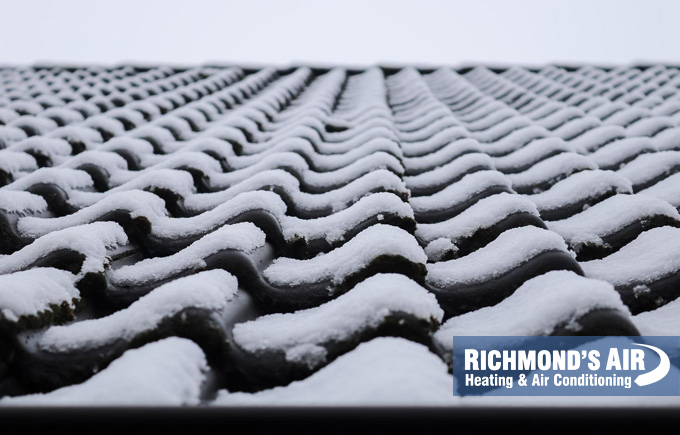Updated: September 10, 2024

Houston is sometimes referred to as the capital of the Sunbelt, which means that most of the year, the weather remains warm. But Texas weather is also notorious for being unpredictable, and recently, residents have been getting hit by frigid cold snaps.
Cold snaps are rapid downward changes in the temperature, usually within a 24-hour period. They’re most commonly seen throughout the United States and Texas in winter but can occur any time of year. Cold snaps are linked to cold fronts—the front edge of a large mass of low-pressure air moving across a region.
These “cold pockets” tend to bring much colder air down from Canada and other parts of North America. They often cause shallow temperatures as they move into a region and weaken the usual large warming gradient between the North and South Pole regions.
Cold spans are becoming more frequent and severe in Texas. In the past 10 years, a fourfold increase in cold snaps of 40 degrees or lower during the winter has caused widespread damage to homes, infrastructure and crops.
There is no such thing as a simple freeze anymore, with the repercussions of cold snaps often lasting for weeks or months, wreaking havoc on homeowners and their residential HVAC systems. The last thing you want is your heater to die on you when you need it most. For this reason, it’s important that you keep your furnace in proper working order.
Since heaters in Texas are used infrequently, Houston homeowners can experience difficulties when their furnace or heating system is actually needed.
Regular furnace maintenance and ensuring that your HVAC unit gets a professional tune-up before the cold winter months kick in will ensure that your family remains warm all year long, even if the temperatures plummet.
Brrrr…don’t miss this 10-point checklist (including both do-it-yourself and professional tasks) to ensure that your home furnace is winter weather ready.
Tracking Houston temperatures
Houston has been keeping a record of its temperatures since 1921. During the first decade of record-keeping, Houston recorded its historical lowest low. This occurred on January 18, 1930, and the temperature was 5 degrees Fahrenheit.
In the last decade, Houston’s coldest days of the year have been relatively warm—the coldest day in 2018 was 19 degrees Fahrenheit. The next coldest day occurred in 2017, when the low temperature was 23 degrees Fahrenheit.
Historic Texas cold snaps
In 1951, Houston saw a historic ice storm. On January 29, the temperature fell below freezing and didn’t rise above freezing again until February 2, 1951. During this 123-hour period, the average temperature hovered below freezing at 28 degrees Fahrenheit.
Along with the freezing temperatures came 1.42 inches of precipitation. This led to one of the most damaging ice storms Houston had ever seen, causing devastating agricultural and livestock losses.
In 1983 and 1989, December was the coldest and second coldest months on record for the Houston area, with 1989 coming in as the coldest.
On December 22, 1989, Houston saw 1.7 inches of snow. This was the last time Houston saw measurable snowfall. According to the National Oceanic and Atmospheric Administration (NOAA), it’s estimated that the 1989 cold snap cost Texas $1 billion in crop losses and other damages (adjusted for inflation). In fact, much of the citrus crop was lost due to freezing temperatures.
In 1983, Houston had below-freezing temperatures for nearly 5 consecutive days. It’s estimated that the 1983 cold snap caused nearly $250 million in damages (adjusted for inflation). Across Texas, 13 people died during the cold snap. North Texas was hit the hardest, with 6 people dying due to the cold and $1.5 million dollars worth of city pipes damaged.
Winter Storm Uri in 2021
Of course, you don’t have to go that far back in time to find a historic winter storm of epic proportions in the Houston area. Although many residents may have initially viewed Winter Storm Uri as a rare opportunity to experience significant snow accumulation in Texas, from February 13-17, 2021, Uri wreaked havoc on Texas’s infrastructure and resulted in a shocking death toll across the South.
Temperatures in Houston fell to 13 degrees Fahrenheit—the city’s coldest recorded temperature since the 1989 cold snap. Rolling blackouts ensued, along with water line breaks.
It’s been widely reported that over two-thirds of Texans experienced power outages during the storm, and almost half of the residents had their water services disrupted. In fact, approximately 10 million Texans received boil-water notices after the storm, many of which lasted for weeks. Unfortunately, low-income and minority communities, who lacked resources to find alternative housing and repair damages, bore the brunt of the disaster’s effects.
The storm ultimately led to over 200 deaths and cost the state somewhere between $80 to $130 billion in storm-related damages.
What’s the impact of cold snaps on Texas?
Texas has seen a severe increase in cold snaps in recent years. Many areas around Texas are now seeing cold snaps that last between 2 and 3 weeks at a time, and this trend is expected to continue over the next decade.
Cold snaps have the potential to be devastating to people, animals and crops. Extreme drops in temperature pose an especially great risk in Texas because power plants and fuel supplies can freeze during a time when the demand for energy to heat homes has soared to unprecedented levels. Additionally, Texas water systems, which rely on energy to pump and treat water, can also be severely affected.
How can Texans prepare for cold snaps?
Cold snaps appear to be here to stay, so it’s crucial that Texans know how to protect themselves and their homes from these storms.
How to protect your home
There are lots of small things you can do to prepare your home for freezing weather that ultimately make a huge difference.
For example, to prevent your pipes from freezing, allow your faucets to drip slightly. If your home is older or not well insulated, you may even want to leave a faucet dripping overnight to prevent any frozen pipes. Especially take caution when temperatures are below freezing and windy, which can speed the freezing process.
Here are some other tips that can help you get ahead of the storm and prepare your home for cold weather:
- Detach any outdoor hoses from your home to prevent them from freezing.
- Seal out cold air by replacing damaged weather stripping around windows, doors, plumbing, and electrical and gas lines.
- Seal all cracks, holes, and other openings in your exterior walls with caulk.
- Wrap vulnerable pipes with pipe insulation.
- Clean your gutters to prevent ice from forming on your roof.
- If your garage is attached to your home, keep it closed if possible.
- Know how to access your water shut-off valve in an emergency.
- Maintain the temperature in your home, even if you’ll be away for a period of time to prevent your pipes from freezing.
- Keep an extra set of batteries for your thermostat handy at all times.
- Keep your bathroom and kitchen cabinet doors open to allow warm air to circulate around the pipes.
Perhaps most importantly, make sure you’ve turned on your heat. It might sound obvious with the cool nights we’ve been having, but if, for some reason, you haven’t turned on your furnace or heat pump yet this season, go ahead and do that now. The worst thing is to turn on the heat when you’re already cold, only to find out that it’s only delivering cold air.
In the Houston area, heat systems that aren’t used too often can get a little “rusty” over time. If you have concerns about your heat pump or furnace, your best bet is to schedule preventative maintenance on your system before cold weather strikes.
How to protect yourself and your family
In addition to getting your home ready for cold weather, you can also take these additional steps to protect your family:
- Stock up on basic necessities like food, bottled water, toilet paper and emergency supplies, including battery-operated radios and flashlights.
- If your heat goes out, keep warm by closing the doors to any rooms you don’t use. You should also dress in layers, wear a hat and gloves, and cover yourself in extra blankets to stay warm.
- If your pipes freeze, try using a hair dryer to thaw them. Never attempt to use a blow torch or anything with an open flame.
- Protect your pets and livestock by moving them indoors or providing suitable shelter when possible. If you’re not accustomed to the chilly weather, neither is your dog or cat, so make sure everyone has a cozy spot for cold nights. If you’re worried about the mess, visit our Heat Beat to learn about ways to keep indoor air quality clean.
- Use space heaters with caution. Any supplemental heat you use in your home should be approved for indoor use. Always turn off these space heaters when you’re not in the room or in bed. Learn more about portable heater safety.
- Never bring outdoor heating devices, such as barbecues or other fuel-burning devices, indoors due to the risk of carbon monoxide poisoning.
How communities can help protect their residents
Communities that experience cold snaps need to have a plan in place to help residents deal with power outages and water shut-offs, including:
- Establishing community centers or shelters where residents can go to stay warm and have access to food and water.
- Providing regular updates on the status of the power outage or water shut-off through social media and local news outlets.
- Coordinating with local businesses to provide essential services, such as grocery stores, pharmacies, and gas stations, with backup power sources.
- Mobilizing volunteers to go door-to-door and check on vulnerable residents, such as the elderly or those with disabilities, and provide them with necessary supplies, such as food, water and blankets.
- Coordinating with local emergency responders, such as police and firefighters, to ensure they have access to the resources they need to respond to emergencies.
- Establishing a hotline or other communication channels where residents can report emergencies or request assistance.
- Offering assistance with emergency repairs, such as fixing burst pipes or generators for those who need it.
Where to find temporary warming centers in the Greater Houston area
Local News KHOU 11
The importance of furnace and HVAC maintenance
While we certainly hope the devastation seen with Winter Storm Uri doesn’t play out in the future, the truth is that you can never predict when an ice storm like Uri will come through these parts again.
As a homeowner, it’s critical to get regular maintenance on your furnace or HVAC system to ensure it’s running efficiently. But if something goes wrong and you lose heat during a cold snap, don’t hesitate to call a professional.
If you’re in the Houston area, contact the experts at Richmond’s Air today. We provide maintenance services to ensure your unit is ready for the cold weather as well as emergency services for when the unexpected occurs.
 Read reviews
Read reviews









